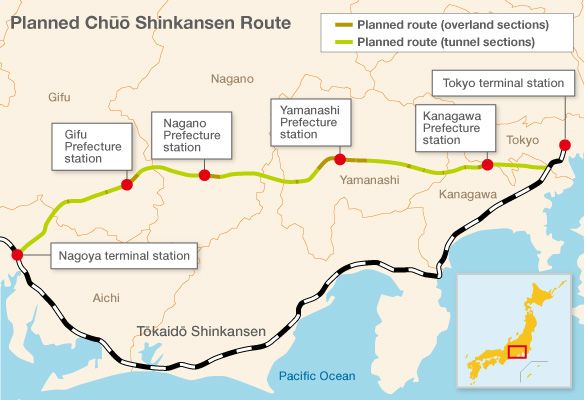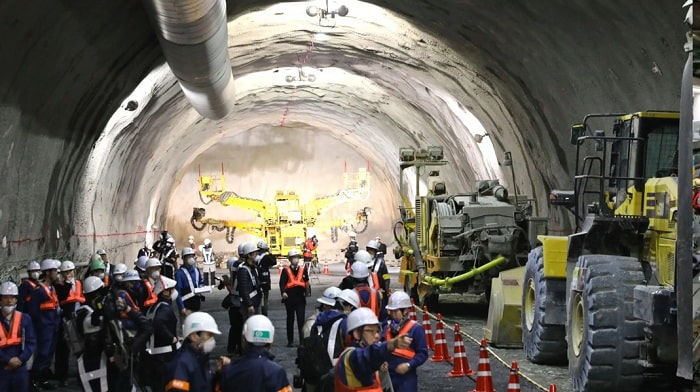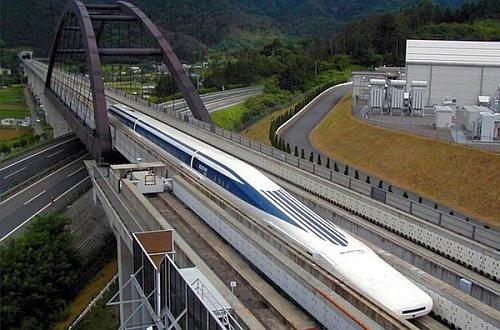The Chūō Shinkansen Maglev Line which is also known as the Tokaido Shinkansen Bypass or Japan’s Maglev High-Speed Rail is a new rail line that is being constructed between Tokyo and Nagoya, with plans for an extension to Osaka.
Also Read: Top Maglev train projects in the world
The rail is being constructed using Maglev technology. Derived from “magnetic levitation” Maglev is a system of train transportation that uses two sets of magnets. One set is used to repel and push the train up off the track, and the other set is used to move the elevated train ahead.
Along certain medium-range routes usually between 320 and 640 km, the maglev trains can move at speeds comparable to that of high-speed rail and airplanes.
Implementation of the project
The Chūō Shinkansen Project is being executed in phases. Phase 1 of the project, which broke ground in December 2014, involves the construction of a 285.6km-long line between Shinagawa Station in Tokyo and Nagoya Station in Nagoya, comprising 256.6km of tunnels, 23.6km of viaducts, 11.3km of bridges, and 4.1km of rail beds.
The route, designed for a maximum speed of 505km/h, will have a minimum curve radius of 1,000m and a maximum grade of 40%, while the distance between the track centers will be nothing less than 5.8m. It will incorporate six stations at Shinagawa in Tokyo, Nagoya in Nagoya, Hashimoto in Kanagawa, Kōfu in Yamanashi, Iida City in Nagano, and Nakatsugawa in Gifu.

This phase is expected to become operational in 2027 connecting Tokyo and Nagoya in 40 minutes. The Nagoya–Osaka section, which forms part of the second phase of the project is planned to be completed in 2037 connecting the two cities in 67 minutes.
The entire Chūō Shinkansen project is developed by Central Japan Railway Company (JR Central).
Timeline
1990-2009
The topographical and geological studies for the project commenced in 1990 and were completed in 2009.
2007
JR Central announced in December that it planned to raise funds for the implementation of the project on its own, without government financing.
Late 2008 to late-2009
The project’s consultation phase was performed.
2011
In May, JR Central was granted the consent to serve as the owner and operator of the Chūō Shinkansen project.
2013
The draft environmental impact statement (DEIS) for Phase 1 of the project was released in September.
2014
In October, the Minister of Land, Infrastructure, Transport, and Tourism granted the approval for the construction implementation plan.
2014
In December, preparation works for the construction of the two stations at both ends of phase one i.e. at Shinagawa and Nagoya commenced.
2015
The construction of the Southern Alps Tunnel in Yamanashi, the deepest point of which is approximately 1,400m below the surface, commenced in December.

2016
In January, the construction of the underground Shinagawa Station commenced.
2017
The creation of a short underground route to central Tokyo from Shinagawa was.
2020
Officials of Shizuoka, in a meeting with JR Central in June, denied permission to begin construction work on the Shizuoka tunnel due to concerns that water from the Ōi River will leak into the tunnel lowering the rivers water level.
March 2021
The construction status on the Chuo Shinkansen scheme was still in the early stages, although a lot of progress had already been made. Construction had already started on the maglev station at Shinagawa, consisting of 4 tracks and 2 platforms. However, since it is being constructed beneath the former Shinkansen station, building will take around 10 years to complete fully, so that it doesn’t interrupt with the current train services. Construction work had also commenced on some of the extensive tunnels that the line will need, including a 25-kilometer tunnel being developed under the southern Japanese Alps, which is set to be the deepest tunnel in Japan when completed. Plans for a 7km tunnel in Yamanashi and Shizuoka had also been revealed. Both tunnels are set to be completed by 2025.
April 2021
It was realised that the construction cost projection for the Shinagawa-Nagoya part had risen by 1.5 trillion yen due to anti-quake measures and other factors. The estimate for the whole scheme, including the eventual extension to Shin-Osaka Station, had risen from 9 trillion yen to over 10 trillion yen.
October 2021
Construction for Chuo Shinkansen maglev train fleet new maintenance depot was marked with a traditional safety prayer ceremony held in Nakatsugawa City, Japan. The Chubu General Train Depot will be developed by a joint venture comprising of JR Tokai Construction Company, Kajima Corporation and Tobishima Corporation and it is set for completion by September 30 2025. The 2000m-long, 400m-wide depot tender was awarded on March 18 2020, with the dvelopment set to cover 50 hectares. The depot will also have a factory where new rolling stock will get assembled and overhauled.

